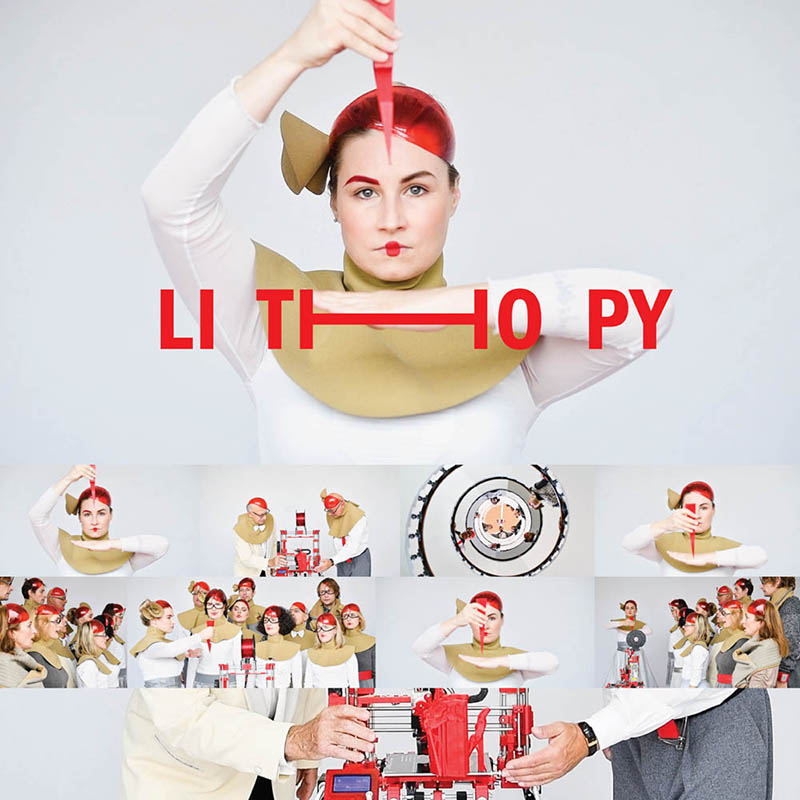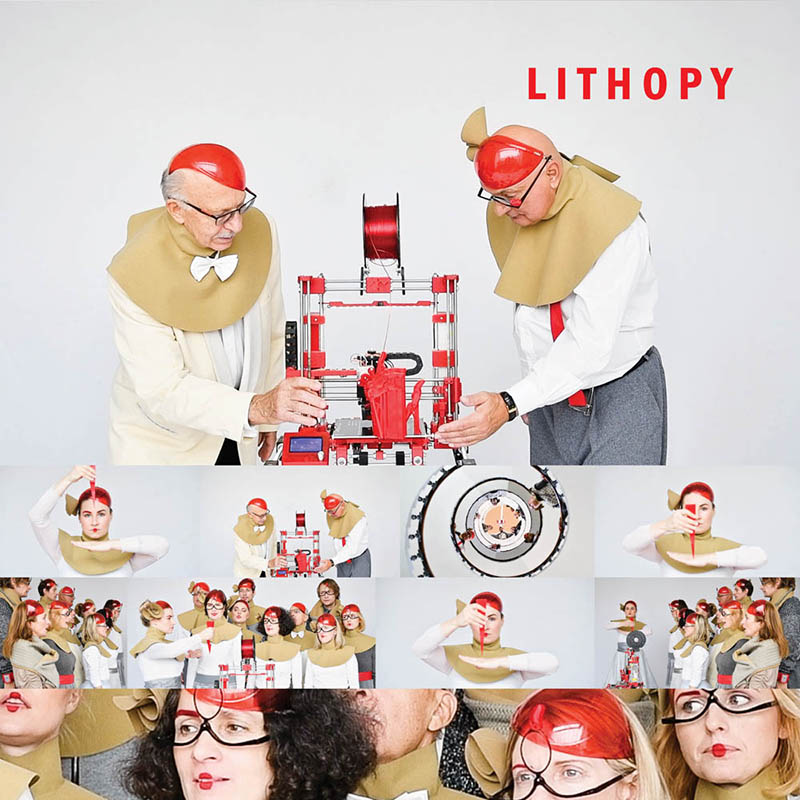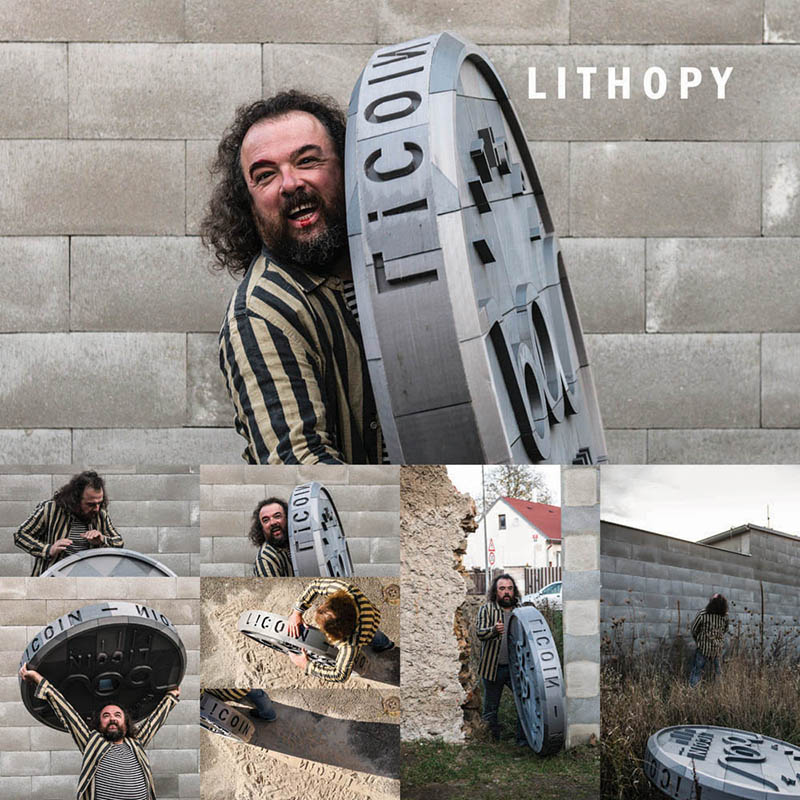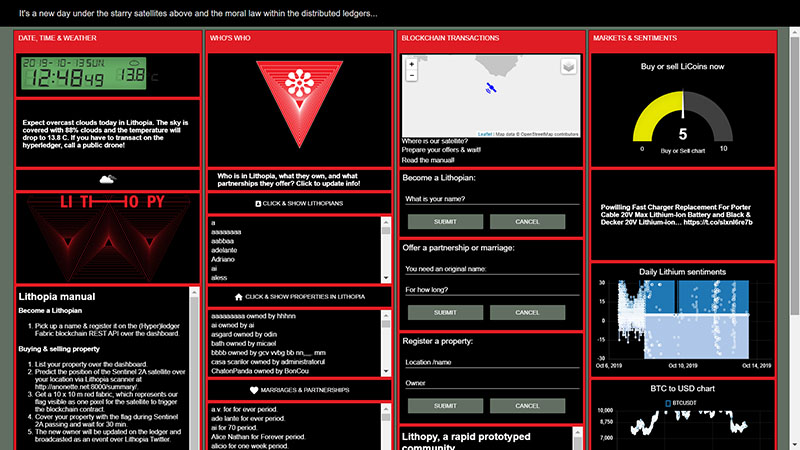




In 2017, an American economist by the name of Milton ‘Crypto’ Freeman aka Blockfree Money 2.0 spent a weekend in the mountains of Lithopia and wrote a fascinating series of tweets about the habits and customs of its inhabitants. He was stunned by the mountain people’s insistence that property and money are a means of preserving a genealogy, rather than a medium of exchange. Like the inhabitants of the Micronesian island of Yap, Lithopians use large 3D printed coins to preserve their oral memory of ownership, marriages, and important events. They deploy these LiCoins in GPS defined locations at a particular UT defined time to make them visible to the satellites they worship over the open API that they developed for using the data of the Sentinel-2 is Earth observation mission from the EU Copernicus Programme. The open source ‘Lithopia Scanner’ (https://github.com/mt-krainski/lithopia_scanner) is then used for rituals that trigger genealogy transactions programmed as smart contracts on the blockchain platform Hyperledger.
As the mountains yield every precious metal in abundance, the inhabitants of Lithopia worshiped various metals through history. Their main source of metaphysical, political and economic speculations is lithium, the first metal that emerged after the Big Bang, known for its universal scarcity. They use the rare lithium sand from their land and mix it with 3D printable plastic to create tokens of ‘cryptocurrency’. LiCoins are similar in size to the famous Rai stones, but they also hide the illegally obtained lithium from the old mines as means of reclaiming the ownership of their natural resources. The LiCoins are moved around to indicate important transactions and contracts on their blockchain private network visible as a ‘business network archive’ file of the Github page (https://github.com/anonette/lithopia). They strongly believe in a power of the Git to manage the universe, so they allow all citizens to commit and fork code on their Github page that serves as a constitution. Their private Lithopia ledger is a form of oral culture timestamping of all transactions that emphasizes genealogy over exchanges and stewardship over ownership.
The 3D printed LiCoins made from the lithium sand found dumped off the local tin mine are meticulously recorded on their ledger with all the conditions (temperature, % of lithium in the sand, water, plastic amounts) and diligently timestamped to guarantee their authenticity. A noteworthy feature of this lithium currency is that it does not have to be physically present. After concluding a transaction that involves a change of ownership of a LiCoin too large to be conveniently moved, its new owner is quite content to accept the bare acknowledgement of the ownership expressed through the GPS time stamped coordinates of its coin and without so much as a mark to indicate the exchange, the coin remains undisturbed on the former owner’s premises while the transaction is deployed through a smart contract on the Hyperledger platform.
The same is true for house facades with glittering lithium plasters. Often run down and only moderately decorative the lithium facades are much valued, sometimes more than the actual house and land. Unnoticed as they go by strangers, the lithium plasters are important to the local community as hidden treasures. The community serves as a distributed ledger: its members virtually verify and keep record of every transaction through their smart contracts and abundance of time stamped data.
Milton ‘Crypto’ Freeman’s faithful old friend, Meynard ‘Abbé’ Kaynes, assured him that in the Lithopia village the wealth of a family is acknowledged by everyone — and yet no one, not even the family itself. No one ever had laid eye or hand on this wealth; it consisted of over a hundred square meters of lithium plaster, where the size is only known by tradition; for the past two generations it had been, and at that very time it was lost any sight of it! It exists only a legend on the Lithopia ledger.
Many years ago an ancestor of the family, on an expedition after lithium sand, secured this remarkably white and exceedingly valuable load of glittering sand, which was loaded onto lorry to be brought homeward. Then all of sudden, the police appeared, and the party, to stay out of trouble, dumped the whole load of precious sand down the river; their sand was flushed out of sight into common ownership. When they reached home, they all testified that their sand was of extraordinary quality, and that it was lost through no fault of the owner. Thereupon it was universally conceded in their simple faith that the mere accident of its loss was too trifling to mention, and that ought not to affect its marketable value, since it would have made for a magnificent facade. The purchasing power of that lithium sand remains, therefore, as valid as if it were plastered visibly on the walls of the owner’s house.
Milton ‘Crypto’ Freeman’s immediate reaction was: “How silly. How can people be so illogical?”. But he tweeted the next day to apologise: “Before criticising too severely the innocent people of the Ore Mountains, it is worth contemplating the way our bank account, our credit card or cryptocurrency wallet work”. The Lithopia’s crisis may not be that famous as the 2008 economic crisis, but their idiosyncratic ledger system helped them survive and strive against all odds. They are particularly suspicious of Silicon Valley exported futures against which they regularly deploy locally designer artistic vaporware and appropriations of funny code that is part of the national pavilion. They share their story, code and strategy so people everywhere can claim their natural resources and design their own smart contracts.
Lithopia is a brave attempt by few villagers from the Czech lands to reclaim their cosmological heritage of rich Lithium deposits in an age of speculative cryptocurrencies and energy futures dictated by Silicon Valley, Russian interests and various geopolitical games. Lithium was created within the first hundred seconds of the Universe, and it is first metal after the Big Bang, so speculating and using lithium is as much about future industries as it is about our origins and past.
Lithium punk national pavilion
The Ore Mountains in Bohemia have a long history of mining going back to the Middle Ages that attracted various colonialists, speculators, adventured and alchemists trying to turn some dark and useless matter into gold The flashy Lithium populisms mixed with Polynesian appropriations and open source code is our unique solution to the current crises and reminding everyone of Bohemia as the cradle of automation, robots and dollars.
The Czech Lands have been always known by mining and extraction of rare materials and metals, for example the medieval Czech silver currency “tolar” that gave name to the American Dollar. In last decades the Ore Mountains have been rediscovered as one of the largest world lithium reserves. This staple for lithium batteries driving the future of automated vehicles industry is still driving the interest of various lobbyist. While the politicians were quarrelling about the right to mine lithium, the Lithopians from the nearby villages contacted few developers and philosophers and asked for help. They tried to save the facades of their family houses that used illegally obtained lithium powder from the new colonisers. In the 1980s the former miners considered lithium glittering powder as a junk material freely available for facades of their houses they built in this time. Nowadays, they present a family treasure and a response to the ongoing lithium corruption and speculation with a little help of artistic vaporware that promises more than it can deliver. The performances in front of satellites to trigger blockchain smart contracts may not be the most efficient and smart solution, but it offers a precedent. It is more of a ritual that a business plan or a policy solution connecting the Big Bang nucleosynthesis with modern day blockchain hypes and exploring ideas of owning your future.
Lithium Punk from Bohemia as a theme for the national pavilion is a Czech response to the post-scarcity, techno-utopia behind the popular Solar Punk movement. Instead of solarpunk fantasies, we offer a dark, lithium inspired sarcasm. The installation of plastic and lithium waste objects together with our artistic vapourware link the present corruption and financial speculations to the Big Bang cosmology. The installation and the Github open source project respond critically, materially, and metaphorically to the problem of Earth minerals extraction, resources scarcity and man’ s drive to endless energy production and newest search for perpetuum mobile. This lithium ‘punk’ speculations from the impoverished Czech northern provinces aim at bringing a unique take on issues of technological craftsmanship and folklore. They perform and mock present fantasies of automation, blockchain technologies etc. as the modern version of the old alchemist dreams of limitless energy sources, perpetuum mobile, that will bring liberation and end the of colonialism. It also mocks the current speculative craze in ICOs by allowing you to invest in facades in a ghost mining town to support the local ex-miners as co-investor.
Since lithium is the first metal after the Big Bang, the project poses important questions of stewardship of this source created in the first seconds of the universe. Who is the rightful owner of our cosmological heritage? From Big Bang nucleosynthesis to modern day corruption the lithium and all our metals and minerals are a constant source of conflicts. We offer low tech, messy folklore and DIY hacks for everyone to explore these issues and come up with their own version of Lithopia. Even if you are not about to set up an activist takeover of your local resources, you can still use our Lithopian Github page and installation to explore issues of algorithmic governance and take part in our workshops and adventures where we design the future smart contracts and create a space for code to meet metals, satellites to meet ledgers and make smart villages instead of cities.
Lithopia Punk history and geography
The origin of the genre refers to Ore mountains and Cinovec = the Mountain of Tin / Zinnwald = Tinwood is an ancient mining hamlet in the rust belt at the Czech German border. This mountain stands for staple, a place of supply, a source.
It was tin, a rare metal in Europe and the staple of Bronze Age, that gave this mountain its name.
Tin was followed by tungsten, for filament in classic light bulbs and the staple in cold war arms race.
While mining for tin and tungsten, miners had been digging a silvery metal out of the mountain. They may have been familiar with the stuff. It was lithium. Anyway, it was considered a junk and lithium mica glittered under the sun. The glittering sand became popular among miners who built houses for their families in the surrounding area, which gave birth to phaenomenon of lithium-clad houses of the Cinovec area.
The tungsten mining was closed down after the border opened, the arms race stopped and a new technology redefined tungsten filament bulbs as heating units. Miners lost their jobs, the rust took up its silent work. Only facades of their houses glitter under the sun. All of sudden, the Mountain of Lithium was born out of the eviscerated Mountain of Tin and Tungsten, once again pregnant with promise.
It’s time for lithium, the lightest metal and the staple of lithium battery, the leading technology in electricity storage. Some 3% of World’s lithium reserve may be soaked in the hard rock of the Mountain of Tin and Tungsten. Once again, the mountain stands for staple, the promise of supply, the source of wealth. In the meantime, emotions ran high, as the Mountain of Promise became the staple of election race and its discontents were virtually mined for campaign promises (many of them contradictory or even mutually exclusive). The lithium facades kept glittering under the sun. Made of the then junk, their apparent disregard for value, commodity and promise makes them void of any credit, their sin of décor is perpetuating the inherited lack of frugality, this is the place of non-supply, the non-source. Now imagine what would happen to them if we mine them as cryptocurrency.
A Sunny Day in Lithopy
It is a sunny day in Lithopy, a quackerish-hackerish community given to transparency, justice and accountability. In Lithopy, sunny days are made for transactions. No clouds prevent satellites from keeping an eye on you. Satellites track your every move. A decentralized, distributed and public digital ledger of blockchain records every transaction. On sunny days, contracts are made. Assets change hands. People make payments and friends, marry and divorce. Lithopians use coins big enough to catch the eye of a satellite. They shake hands for minutes. When you travel to Lithopy on a sunny day, you never pull your hand back before a Lithopian unless you are less serious about business. In Lithopy, hugs are big and kisses are many to make sure satellites and the blockchain records their affection, love and friendship. There are no excess, no frivolity in their actions. Their all-or-nothing gestures, their fits of laughter, their floods of tears are in fact all well measured. You may notice the furtive looks they cast toward the sky. Whatever Lithopians do on sunny days, they do before the face of satellites. In Lithopy, all social contact is a smart contract.
Smart contract from Lithopia
/**
* LithopiaPlaceSold transaction triggered by satellite data changing the owner of a property
* @param {org.lithopia.basic.LithopiaPlaceSold} lithopiaPlaceSold – the LithopianPlaceSold transaction
* @transaction
*/
async function selling(lithopiaPlaceSold) { // eslint-disable-line no-unused-vars
const place = lithopiaPlaceSold.place;
const flag = place.flagColors[0].flagColor;
// if thecolor didn’t change, the owner remains
if (flag === ‘red’){
place.owner = lithopiaPlaceSold.newOwner.name;
}
else{
place.owner = lithopiaPlaceSold.place.owner;
}
// update the newOwner
const assetRegistry = await getAssetRegistry(‘org.lithopia.basic.LithopiaPlace’);
await assetRegistry.update(place);
// emit who is the old or new owner
let placeEvent = getFactory().newEvent(‘org.lithopia.basic’, ‘LithopiaPlaceTransactions’);
placeEvent.place = lithopiaPlaceSold.place;
placeEvent.newOwner = place.owner;
emit(placeEvent);
}
Lithopian Blockchain Providence
Lithopia streaming packets service (pay per packet) on the blockchain where all IP packets are fragmented and the 188-byte streaming packets (Packetized Elementary Stream – PES) are individually registered on the ledger. Lithopians decided to measure their time in packets of data to create a ‘blockchain-ed’ paradise. Packets on a ledger fulfil the old dream of a divine providence supervising and managing every occurrence and every creature. They perform what Christianity and Judaism imagined as a continual creation, sometimes described as ( השגחה פרטית; Hashgochoh Protis) and what Descartes in his ‘Meditation III’ describes as a God that conserves the world by continuously creating it, and what Leibnizian imagines as a pre-established harmony. To stream and timestamp packets on the ledger is to design an all-seeing, all present and perpetually seeing God. The timestamps and blocks of all the transactions and activities in the life of the Lithopians is a form of divine providence, but also a magical ritual of protection via God’s eyes.
Acknowledgments
The design fiction work was supported by the Czech Ministry of Culture and the Czech Industrial Design Museum. The research into anticipatory prototyping, governance, and design is supported by Horizon 2020 Marie Curie Individual Fellowship.
